A Special Temple In The Land Of Krsna
In Vrindavan, India, the Krsna-Balarama project shines with the mood of pure devotion to God.
by Yogesvara dasa
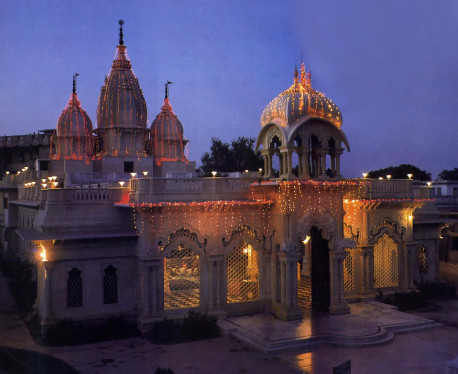
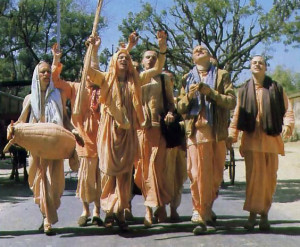
I first learned about Vrndavana from my spiritual master, His Divine Grace A. C. Bhaktivedanta Swami Prabhupada, who at seventy had come from Vrndavana to the streets of New York to found, in 1966, the International Society for Krishna Consciousness. I remember once sitting with him years later in Rome. He had already established many temples in the West, but few of his disciples, myself included, had visited Vrndavana, the town ninety miles south of present-day Delhi where Krsna enacted His childhood pastimes some fifty centuries ago. When I asked him what it was like, he smiled and said, “Oh, it is such a wonderful place that I did not want to leave. But then I thought, ‘Why should I be so selfish? Let me bring Vrndavana to the West and share it with you.'”
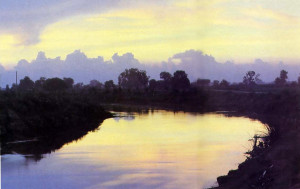
To that end Srila Prabhupada dedicated his every moment. He spread the glories of Vrndavana not by encouraging tourism to India but by teaching the Vrndavana mood of pure devotion to Lord Krsna. In the Bhagavad-gita Lord Krsna Himself describes that mood as “the most secret of all secrets,” the treasure hidden inside India’s vast scriptural library, and the full, ultimate blossoming of the human spirit.
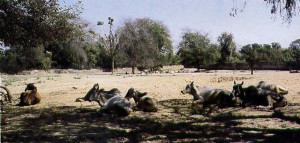 Srila Prabhupada knew how difficult it would be for visitors—especially Westerners steeped in their habits of empiric judgment—to understand the esoteric mood of Vrndavana, for the city is decrepit by Western standards and many temple panditas close their doors to foreigners. So in 1971 he initiated construction of the Krsna-Balarama temple. Here, in relative comfort and opulence, visitors can learn the true secret of this ancient city. Here they can enter into the Vrndavana mood.
Srila Prabhupada knew how difficult it would be for visitors—especially Westerners steeped in their habits of empiric judgment—to understand the esoteric mood of Vrndavana, for the city is decrepit by Western standards and many temple panditas close their doors to foreigners. So in 1971 he initiated construction of the Krsna-Balarama temple. Here, in relative comfort and opulence, visitors can learn the true secret of this ancient city. Here they can enter into the Vrndavana mood.
* * *
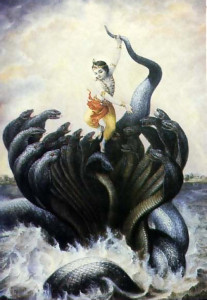
Five hundred years ago, according to scriptural references, Krsna appeared in Bengal as Sri Caitanya Mahaprabhu and inaugurated a renaissance in devotion to Himself. Through philosophical discourses and public chanting of the Hare Krsna mantra. Lord Caitanya established bhakti (devotional service to Lord Krsna) as the essence of the Vedic literature and the very goal of human life.
Before Lord Caitanya’s advent, faulty scriptural interpretations had brought bhakti into disrepute, and the sacred city of Vrndavana had become unmanifest—it now seemed little more than some open fields in northern India. Eager to revive the city. Lord Caitanya empowered His principal disciples, the six Gosvamis, to begin reconstruction and simultaneously to compile books on the science of bhakti.

Lord Caitanya’s purpose was to create in Vrndavana an atmosphere in which one could feel and imbibe the spirit of pure love for God. This purpose the six Gosvamis fulfilled. Unfortunately, in recent years so-called priests known as caste gosvamis, claiming to be direct descendants of Lord Caitanya, have neglected that spirit. They have privately introduced demigod worship (although no genuine devotees of Krsna take part in this) and have allowed their sectarian proprietorship over temples to replace their duty of receiving everyone, regardless of background, and encouraging devotion to Krsna through proper instruction. The Vrndavana mood is one of giving, not possessing, and such small-minded practices have compromised this mood.
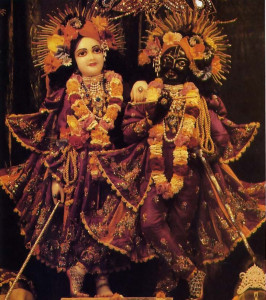
Although the caste gosvamis are only a small minority of Vrndavana’s temple leaders, their influence has had grave consequences. Since Krsna’s temples have been treated as material objects, their sanctity has been ignored. Walls crumble and go unrepaired, sanitation remains hopelessly inadequate. Perhaps most distressing for devotees is that many residents of Vrndavana are now unaware of the greatness of their heritage because of inadequate or inaccurate instruction. As a result, although many people traveling between Agra (the Taj Mahal) and Delhi stop in Vrndavana to sightsee, they miss the real point.
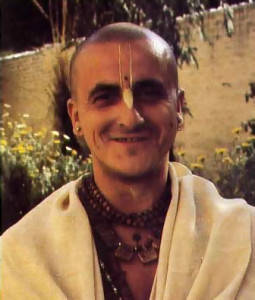
Between 1959 and 1965. Srila Prabhupada resided in Vrndavana, in a small room at the Radha-Damodara temple, translating the Sanskrit texts that would form the foundation of the Hare Krsna movement. At last, at seventy years of age, he set out for the West to broadcast the message of Lord Krsna: All living beings are part and parcel of Krsna, and the goal of human life is to revive our lost relationship with Him and return to His spiritual kingdom, the original Vrndavana, known as Goloka-Vrndavana. Before he passed away in Vrndavana in 1977, Srila Prabhupada urged his disciples (now several thousand strong) to take seriously their duty of preaching the glories of Vrndavana all over the world.
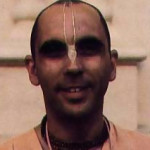
The secret of Vrndavana is that it is not different from Krsna Himself. So a visit to Vrndavana is a direct experience of the eternal spiritual world. The Vedic literature describes that everything connected with the Lord is as worshipable as He, for it partakes of His spiritual nature. A piece of cloth worn by the Deity or a pinch of dust from the land of Vrndavana is often kept in a container on a temple altar and worshiped. Just as Krsna is glorious and worshipable, Krsna’s abode—Vrndavana—is glorious and worshipable. The trees, the roads, the rivers, the peacocks—everything is of the same spiritual nature as Krsna Himself.
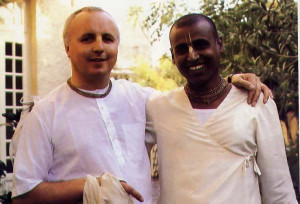
When Krsna descends to this material world, His spiritual kingdom also descends, just as an entourage accompanies an important head of state. So devotees do not consider Vrndavana part of the material world, and they take shelter there with full faith that they are living in Krsna’s own abode.
Another reason Vrndavana is glorious is that Krsna’s divine qualities reveal themselves here in full. Love of God in Vrndavana is devoid of the awe and reverence generally equated with devotion in Western religions. The unique mood of Vrndavana is pure attachment to Krsna without reverence or personal motive. There is a particular glory to that part of Vrndavana called Ramana-reti. The name literally means “pleasurable sands,” or, as Srila Prabhupada described it. “the shimmering silver sands” where the Lord enjoyed pastimes as a cowherd boy with His brother Balarama and Their friends. It was here that Srila Prabhupada chose to build the Krsna-Balarama project.

The location was ideal, but for the glories of Vrndavana to be properly broadcast, the project would have to be built and expanded by expert devotees who understood the Vrndavana mood. Srila Prabhupada envisioned a team of fully surrendered devotees who would rebuild the city—starting with Ramana-reti—and inspire others to carry that devotional spirit to all corners of the globe.
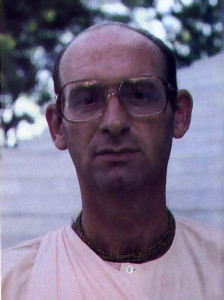
The devotees of the Krsna-Balarama project have worked hard to fulfill Srila Prabhupada’s vision. Their success is visible in the progress of constant construction and expansion, in the vitality of the international gurukula school, in the hundreds of guests from around the world who visit each month after hearing of the project. It is there in the constant chanting of the holy names, in the mass distribution of prasadam (sanctified foods offered to the Deities of Krsna and Balarama), and in the consummate devotional practices. In fact, there is no higher standard of worship anywhere in Vrndavana. Pujaris (temple attendants) from other temples come to study the standard set by Orhkara dasa, head pujari at the Krsna-Balarama temple.
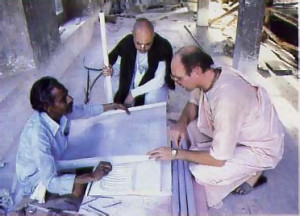
“I try to instill a real sense of personalism in the Deity worship,” French-born Omkara says. “After all, Krsna is the Supreme Person. Pujaris must learn to care for Him as such, with love and devotion. That is what pleases Krsna. Otherwise, just reciting mantras and going through the motions—ritual, that’s all.”
In Vrndavana and surrounding villages, devotees live happily by protecting cows and cultivating simple crops. Krsna Himself showed how an agricultural economy based on cow protection could solve all economic problems. Bulls pull the plow, dried cow dung serves as fuel for heating, cooking, and even electricity, and cow’s milk of course is a staple food from which hundreds of other preparations can be made.
Gunarnava dasa, the Welsh-born president of the Vrndavana project, remembers when the temple acquired its first cow. “Srila Prabhupada told me back in 1972 that his disciples in India were getting sick from drinking buffalo milk. It was necessary, he said, that we produce our own cow’s milk. So I saved up a few rupees and bought two cows. Now there are nearly seventy in our gosala [dairy complex], and some government officials who recently came to inspect said this was the best gosala in the whole Agra district. That’s because the cows know they are loved and protected and in return they give abundant milk, just as when Krsna was present.”
The gosala, a mile down the road from the main temple, resounds with the cooing of peacocks and wild parrots. Time seems to stand still here, and that may be a mixed blessing: while invoking Krsna’s presence with its tranquility, the country-resort-like atmosphere can lead to lethargy.
“Staying in Vrndavana can be both agony and ecstasy,” says Dutch-born Surabhir-abhipalayantam Swami. Architect for many ISKCON projects, including the Krsna-Balarama temple, he has spent the last ten years traveling extensively throughout India. “In one sense, the very deep relationship between the individual and God that is nourished in Vrndavana is just too high for most people to grasp. Without great spiritual insight, you can fall asleep here. So Srila Prabhupada gave us a varied program of worship and practical service. Actually, he wanted gosvamis [advanced, renounced devotees] to run our temple in Vrndavana, people one hundred percent committed to Vrndavana, like the six Gosvamis. Of course, the original gosvamis are still known and accepted by scholars as the founders of the Vaisnava [devotional] renaissance, but the concept of how bhakti can be applied in the world today—that was Srila Prabhupada’s specific contribution. He translated Lord Caitanya’s vision into a contemporary, international language.”
Surabhi Swami envisions great things for the future. His main project now is building on the Krsna-Balarama grounds an elaborate samadhi tomb, a memorial to Srila Prabhupada, whose body is interred near the entrance to the temple. In addition, Surabhi Swami has planned several more guesthouses (the present one can receive up to 250 visitors), a theater for devotional dramas, another building for the gurukula school, expansion of the gosala into a full-fledged dairy farm with the biggest cow protection program in all of India, and more renovation efforts elsewhere in Vrndavana. “It will start here.” he says, “from Krsna-Balarama. Then we can extend the Krsna culture around the world.”

That expansive ambition seems to pervade the project. Nobody thinks small at Krsna-Balarama. American-born Dhanurdhara Swami, who holds a degree in education from the State University of New York and is headmaster of the Bhaktivedanta Gurukula at Krsna-Balarama, sees the school as Vrndavana’s gift to the future. ” It may be India’s traditional system of education, but it is meant for the whole world,” he says. “In this country we receive great encouragement, because people are aware of the importance of spiritual training for young people. During the hot summer months we take the boys traveling all over India, and people constantly shower us with gifts and invitations to their homes. They feel honored to receive gurukula students, whom they see as the spiritual leaders of tomorrow.”

In addition to standard academic instruction, gurukula students learn devotional arts. Bhaktisiddhanta dasa, who met devotees while studying art in Italy on a U.S. Government fellowship, directs the crafts workshops in Vrndavana. Trained as a professional painter and sculptor, he finds working in Vrndavana both materially and spiritually advantageous. “The traditional arts evolve from realization,” he explains. “In Vrndavana, an artist is surrounded by Krsna’s transcendental world, so the inspiration for making art happen is always around us. Not only for its inception, but for its meaning and growth as well. Also, primary materials are in abundance, so production costs are lower than anywhere else I know of. It’s an ideal combination.”
Bhaktisiddhanta has taken part in the expansion of the Krsna-Balarama complex for more than five years, acting as draftsman in the arduous task of translating concepts into detailed architectural plans. He is Surabhi Swami’s chief assistant on the samadhi construction.
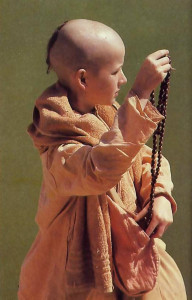
Apart from the hundreds of European and American devotees who come to visit Krsna-Balarama twice a year during traditional festivals, tourists constantly fill the guesthouse and vegetarian restaurant, which are considered Vrndavana’s finest. The Krsna-Balarama devotees bend over backwards to make their guests feel as comfortable as possible. Indian-born Tapo-maya dasa, manager of the guesthouse, generally has to bend a little more than the others. “A pilgrimage doesn’t have to be a great austerity,” he says. “Many people just wouldn’t come if there were no guesthouse.” He proudly pulls out the house’s guest book. Comments such as “a memorable visit” and “a very cordial stay” are signed by government officials, university scholars, and a few notable celebrities from the stage and screen.
Cuban-born Krta-karma dasa, Krsna-Balarama’s vice-president, reflects on the project’s mosaic of nationalities. “Srila Prabhupada broadcast Vrndavana’s glories through his books, which have gone out by the millions around the world. That is why we receive so many nationalities here. Sometimes, in our Bhagavad-gita classes. we have to translate into five languages. Among the devotees living here are Americans, Italians, Indians, Swiss, and Canadians. The leader of our chanting party is the son of the British attache to Israel. Our registrar is from Scotland. As for me, well, we get a lot of Russian visitors, and they are often surprised to find a Cuban who has renounced the materialism of the West to take to spiritual life. This is really a United Nations of the spiritual world.”

Krta-karma tells about an elderly man from Damascus who had received an Arabic translation of Srila Prabhupada’s Bhagavad-gita and decided that to find spiritual life and God he would have to see India. “Not just anywhere in India,” Krta-karma recalls, “but Vrndavana. He came and spent practically the whole time here at Krsna-Balarama. Of course he visited the many temples and holy places, which is only proper, but like many others he soon realized that at Krsna-Balarama Srila Prabhupada has built an oasis of pure spiritual life. There are no caste distinctions here, no decay from negligence—nothing but devotional service to Krsna. Naturally, Krsna is everywhere in Vrndavana, but here His presence is distinct and clear.”
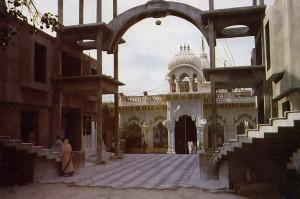
Surabhi Swami adds, “I remember my own initial contact with devotees, when I was first coming around to the temple in Amsterdam. Everyone there spoke so eloquently about this magical place called Vrndavana that I decided I had to go and find out for myself whether everything they were saying was true. I think that’s what Srila Prabhupada had in mind for the Krsna-Balarama project: a confirmation that the spiritual world really does exist.”
After you speak with the devotees, your vision of Vrndavana changes. The squalor fades and a sense of transcendence emerges. To enhance that sensation, sit in the marble courtyard of the Krsna-Balarama temple and listen to the Sanskrit and Bengali poetry the devotees sing while playing mrdanga drums and small brass cymbals. Watch the constant flow of visitors, or go chanting in the afternoon with the sixty children of the gurukula through the streets and marketplaces of the city. Gradually the Vrndavana mood sets in, and one begins to appreciate some of the glories of this wonderful place, Vrndavana.

Leave a Reply